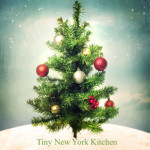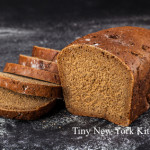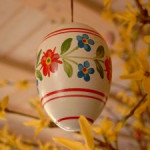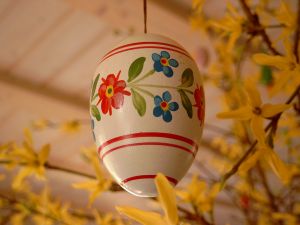The modern day Christmas tree was developed in early modern Germany, with predecessors that can be traced to the 16th and even possibly the 15th century. Devout Christians brought decorated trees into their homes. During the second half of the 19th century Christmas trees (also known as the Yule-tree) became popular beyond Germany, at first among the upper classes. Trees were traditionally decorated with apples, nuts, and other foods. During the 18th century people began to add illuminated candles, which were ultimately replaced by Christmas lights after the invention of electrification. During the early 19th century the Christmas tree became very common in the United States due to German immigrants settling Eastern and Midwestern towns. News spread of the Christmas tree between 1850 to 1860 by “Godey’s Lady’s Book,” and soon it became a common Christmas tradition.
www.tinynewyorkkitchen.com
“Work With What You Got!”
© Victoria Hart Glavin Tiny New York Kitchen © 2016 All Rights Reserved
Easter celebrates the resurrection of Jesus, but is also associated with popular symbols such as eggs, candy, bunnies and food. Here is a look at the origins of these beloved symbols.
The Easter Lily
The white blossoms of the lily symbolizes the purity of Jesus. The trumpet-shaped flower that blooms in the spring also symbolizes new life and the resurrection of Jesus Christ. People use the flower to celebrate and enjoy the very essence of the Easter season.
Hot Cross Buns
A favorite during spring and the Easter season. Hot cross buns are a sweet, yeast leavened, spiced roll made with currants or raisins. They have long been a symbol of Good Friday. Each bun has an icing cross on top to signify the crucifixion.
The Butterfly
The butterfly’s unique life cycle is meant to symbolize the life of Jesus Christ. The first stage, the caterpillar, stands for his life on Earth. The cocoon stage portrays the crucifixion and the burial of Jesus. The final stage, the colorful butterfly, represents Jesus rising from the dead and the resurrection.
Easter Baskets
In Germany, children made nests in which the “Osterhase” or Easter Bunny could lay his colored eggs. The nests were replaced with baskets once the tradition was brought to the United States and the Easter contents were expanded to include candy and other treats.
Easter Ham
In the United States ham has become a traditional Easter dish. In the early days, meat was slaughtered in the fall. There was no refrigeration so the fresh pork that wasn’t consumed during the winter was cured for spring. This made ham a natural choice for the celebratory Easter dinner.
Easter Egg Hunts & Rolls
The first official White House egg roll took place in 1878 under the presidency of Rutherford Hayes. Egg hunts and rolls have no religious connection, but some will point out that the roll is a symbolic act for the removal of the stone blocking Jesus’ tomb.
Easter Parade
The origin of Easter parades dates back to the mid-1800’s in New York City. The wealthy used Easter as an opportunity to show off their new spring wardrobe by walking up and down Fifth Avenue after church. Soon the less fortunate started showing up to watch the spectacle and a tradition was born.
Easter Candy
Second only to Halloween in candy sales, Easter is a holiday for children and adults with a serious sweet tooth. Chocolate eggs and candy shaped like bunnies or eggs are extremely popular. Also, jelly beans are often associated with the holiday due to their egg-like shape.
The Egg
Easter eggs are likely linked to pagan traditions, but eggs have long been used to celebrate spring and the idea of renewal. It’s not unusual that in almost all ancient cultures, eggs are held as a symbol of life. At the Passover Seder, a hardboiled egg dipped in salt water symbolizes both new life and the Passover sacrifice offered at the Temple of Jerusalem.
The Easter Bunny
The cute furry creature is certainly not mentioned in the Bible, but has nonetheless become the most well-known symbol for the spring holiday. The Easter Bunny’s origins are not entirely known, but some stories date his arrival in the United States back to the 1700’s when German immigrants brought their tradition of an egg laying hare called “Osterhase” to the country. Much like children leave cookies for Santa, boys and girls leave carrots out for the Easter Bunny in case he got tired from hopping around all night.









